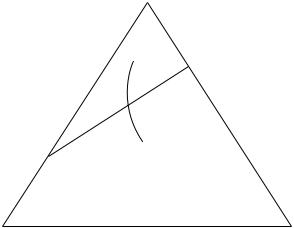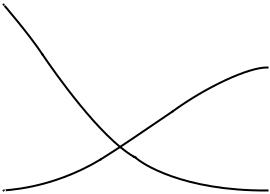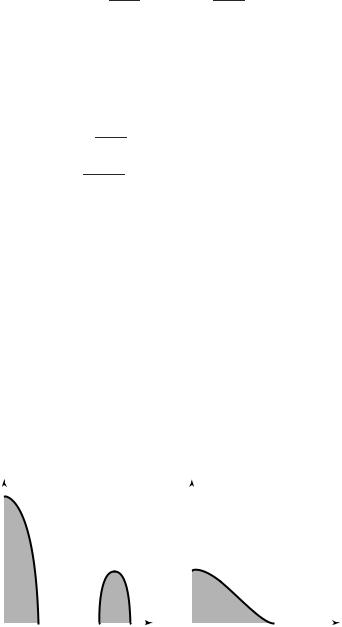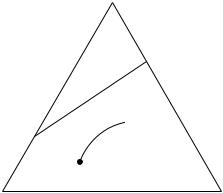
Теория информации / Cover T.M., Thomas J.A. Elements of Information Theory. 2006., 748p
.pdf11.9 CHERNOFF INFORMATION |
385 |
hypotheses. In this case we wish to minimize the overall probability of error given by the weighted sum of the individual probabilities of error. The resulting error exponent is the Chernoff information.
The setup is as follows: X1, X2, . . . , Xn i.i.d. Q. We have two hypotheses: Q = P1 with prior probability π1 and Q = P2 with prior probability π2. The overall probability of error is
|
Pe(n) = π1αn + π2βn. |
(11.229) |
|||||||||
Let |
|
|
|
|
|
|
|
|
|
|
|
D |
|
lim |
|
1 |
log min |
P (n). |
(11.230) |
||||
|
|
|
|||||||||
|
|
|
|||||||||
|
= n→∞ |
− n |
|
An X n |
e |
|
|||||
Theorem 11.9.1 (Chernoff ) |
The |
best |
achievable |
exponent in the |
|||||||
Bayesian probability of error is D , where |
|
|
|
|
|||||||
D = D(Pλ ||P1) = D(Pλ ||P2), |
(11.231) |
||||||||||
with |
|
|
|
|
|
|
|
|
|
|
|
Pλ = |
P1λ(x)P21−λ(x) |
|
, |
(11.232) |
|||||||
a X P1λ(a)P21−λ(a) |
|||||||||||
and λ the value of λ such that |
|
|
|
|
|
|
|
|
|
||
|
|
|| |
|
= |
D(Pλ |
|| |
|
|
(11.233) |
||
D(Pλ P1) |
|
|
P2). |
||||||||
Proof: The basic details of the proof were given in Section 11.8. We have shown that the optimum test is a likelihood ratio test, which can be considered to be of the form
1 |
log T . |
(11.234) |
|
D(PXn ||P2) − D(PXn ||P1) > |
|
||
n |
|||
The test divides the probability simplex into regions corresponding to hypothesis 1 and hypothesis 2, respectively. This is illustrated in Figure 11.10.
Let A be the set of types associated with hypothesis 1. From the discussion preceding (11.200), it follows that the closest point in the set Ac to P1 is on the boundary of A and is of the form given by (11.232). Then from the discussion in Section 11.8, it is clear that Pλ is the distribution

386 INFORMATION THEORY AND STATISTICS
 P1
P1
 Pl
Pl
 P2
P2
FIGURE 11.10. Probability simplex and Chernoff information.
in A that is closest to P2; it is also the distribution in Ac that is closest to P1. By Sanov’s theorem, we can calculate the associated probabilities of error,
α |
n = |
P n(Ac) |
. |
2−nD(Pλ ||P1) |
(11.235) |
|
1 |
= |
|
|
|
and |
|
|
|
|
|
β |
P n(A) |
. |
2−nD(Pλ ||P2). |
(11.236) |
|
|
n = |
2 |
= |
|
|
In the Bayesian case, the overall probability of error is the weighted sum of the two probabilities of error,
. |
. |
Pe = π1 |
2−nD(Pλ||P1) + π22−nD(Pλ||P2) = 2−n min{D(Pλ||P1),D(Pλ||P2)}, |
|
(11.237) |
since the exponential rate is determined by the worst exponent. Since D(Pλ||P1) increases with λ and D(Pλ||P2) decreases with λ, the maximum value of the minimum of {D(Pλ||P1), D(Pλ||P2)} is attained when they are equal. This is illustrated in Figure 11.11. Hence, we choose λ so that
D(Pλ||P1) = D(Pλ||P2). |
(11.238) |
Thus, C(P1, P2) is the highest achievable exponent for the probability of error and is called the Chernoff information.


388 INFORMATION THEORY AND STATISTICS |
|
|
|
|
|
|
|||
Now for any two positive numbers a and b, we have |
|
||||||||
{ |
} ≤ |
aλb1−λ for all 0 |
≤ |
λ |
≤ |
1. |
|
(11.244) |
|
min a, b |
|
|
|
|
|||||
Using this to continue the chain, we have |
|
|
|
|
|
|
|||
|
Pe = min{π1P1, π2P2} |
|
|
(11.245) |
|||||
|
|
≤ (π1P1)λ(π2P2)1−λ |
|
|
(11.246) |
||||
|
|
≤ P1λP21−λ. |
|
|
|
|
|
(11.247) |
|
|
|
|
|
|
|
n |
|
Pk (xi ), and |
|
For a sequence of i.i.d. observations, Pk (x) = i=1 |
|
||||||||
Pe(n) ≤ π1λπ21−λ P1λ(xi )P21−λ(xi ) |
(11.248) |
||||||||
|
|
|
i |
|
|
|
|
|
|
|
= π1λπ21−λ P1λ(xi )P21−λ(xi ) |
(11.249) |
|||||||
|
|
|
i |
|
|
|
|
|
|
|
≤ x |
P1λP21−λ |
|
|
|
|
|
(11.250) |
|
|
|
i |
|
|
|
|
|
|
|
n
= P1λP21−λ , (11.251)
x
where (11.250) follows since π1 ≤ 1, π2 ≤ 1. Hence, we have |
|
|
1 |
P1λ(x)P21−λ(x). |
|
n log Pe(n) ≤ log |
(11.252) |
|
Since this is true for all λ, we can take the minimum over 0 ≤ λ ≤ 1, resulting in the Chernoff information bound. This proves that the exponent is no better than C(P1, P2). Achievability follows from Theorem 11.9.1.
Note that the Bayesian error exponent does not depend on the actual value of π1 and π2, as long as they are nonzero. Essentially, the effect of the prior is washed out for large sample sizes. The optimum decision rule is to choose the hypothesis with the maximum a posteriori probability, which corresponds to the test
π1P1(X1, X2, . . . , Xn) > |
|
π2P2(X1, X2, . . . , Xn) < 1. |
(11.253) |

11.9 CHERNOFF INFORMATION |
389 |
Taking the log and dividing by n, this test can be rewritten as
1 π1 |
1 |
log |
P1(Xi ) |
< |
|
|||
|
log |
|
+ |
|
|
> 0, |
(11.254) |
|
n |
π2 |
n |
P2(Xi ) |
|||||
|
|
|
|
|
i |
|
|
|
where the second term tends to D(P1||P2) or −D(P2||P1) accordingly as P1 or P2 is the true distribution. The first term tends to 0, and the effect of the prior distribution washes out.
Finally, to round off our discussion of large deviation theory and hypothesis testing, we consider an example of the conditional limit theorem.
Example 11.9.1 Suppose that major league baseball players have a batting average of 260 with a standard deviation of 15 and suppose that minor league ballplayers have a batting average of 240 with a standard deviation of 15. A group of 100 ballplayers from one of the leagues (the league is chosen at random) are found to have a group batting average greater than 250 and are therefore judged to be major leaguers. We are now told that we are mistaken; these players are minor leaguers. What can we say about the distribution of batting averages among these 100 players? The conditional limit theorem can be used to show that the distribution of batting averages among these players will have a mean of 250 and a standard deviation of 15. To see this, we abstract the problem as follows.
Let us consider an example of testing between two Gaussian distributions, f1 = N(1, σ 2) and f2 = N(−1, σ 2), with different means and the same variance. As discussed in Section 11.8, the likelihood ratio test in this case is equivalent to comparing the sample mean with a threshold. The Bayes test is “Accept the hypothesis f = f1 if Xi > 0.” Now assume that we make an error of the first kind (we say that f = f1 when indeed f = f2) in this test. What is the conditional distribution of the samples given that we have made an error?
We might guess at various possibilities:
•The sample will look like a ( 12 , 12 ) mix of the two normal distributions. Plausible as this is, it is incorrect.
•Xi ≈ 0 for all i. This is quite clearly very unlikely, although it is conditionally likely that Xn is close to 0.
•The correct answer is given by the conditional limit theorem. If the
true distribution is f2 and the sample type is in the set A, the conditional distribution is close to f , the distribution in A that is closest to f2. By symmetry, this corresponds to λ = 12 in (11.232). Calculating



392 INFORMATION THEORY AND STATISTICS
the probability of winning is 2−nD(P2 ||P2). What if he uses a mixture of strategies? Is it possible that 2−nD(Pλ ||Pλ), the probability of winning with
a mixed strategy, Pλ = λP1 + (1 − λ)P2, is better than the probability of winning with either pure passing or pure running? The somewhat surprising answer is yes, as can be shown by example. This provides a reason to use a mixed strategy other than the fact that it confuses the defense.
We end this section with another inequality due to Chernoff, which is a special version of Markov’s inequality. This inequality is called the
Chernoff bound.
Lemma 11.9.1 Let Y be any random variable and let ψ (s) be the moment generating function of Y ,
Then for all s ≥ 0, |
ψ (s) = EesY . |
(11.260) |
||
|
|
|
|
|
Pr(Y ≥ a) ≤ e−sa ψ (s), |
(11.261) |
|||
and thus |
≥ |
|
≤ s 0 |
|
Pr(Y |
|
(11.262) |
||
|
a) |
min e−sa ψ (s). |
||
≥
Proof: Apply Markov’s inequality to the nonnegative random variable
esY .
´
11.10 FISHER INFORMATION AND THE CRAMER – RAO INEQUALITY
A standard problem in statistical estimation is to determine the parameters of a distribution from a sample of data drawn from that distribution. For example, let X1, X2, . . . , Xn be drawn i.i.d. N(θ, 1). Suppose that we wish to estimate θ from a sample of size n. There are a number of functions of the data that we can use to estimate θ . For example, we can use the first sample X1. Although the expected value of X1 is θ , it is clear that we can do better by using more of the data. We guess that the best estimate of θ is the sample mean Xn = n1 Xi . Indeed, it can be shown that Xn is the minimum mean-squared-error unbiased estimator.
We begin with a few definitions. Let |
{f (x; θ )}, θ , denote |
an |
||
indexed family of densities, f (x; θ ) ≥ 0, |
f (x; θ ) dx = |
1 for all θ . |
||
Here is called the parameter set. |
|
|
|
|
Definition An estimator for θ for |
sample size n is |
a function |
T : |
|
Xn → . |
|
|
|
|

´ |
393 |
11.10 FISHER INFORMATION AND THE CRAMER – RAO INEQUALITY |
An estimator is meant to approximate the value of the parameter. It is therefore desirable to have some idea of the goodness of the approximation. We will call the difference T − θ the error of the estimator. The error is a random variable.
Definition The bias of an estimator T (X1, X2, . . . , Xn) for the parameter θ is the expected value of the error of the estimator [i.e., the bias is Eθ T (x1, x2, . . . , xn) − θ ]. The subscript θ means that the expectation is with respect to the density f (·; θ ). The estimator is said to be unbiased if the bias is zero for all θ (i.e., the expected value of the estimator is equal to the parameter).
Example 11.10.1 Let X1, X2, . . . , Xn drawn i.i.d. f (x) = (1/λ) e , x ≥ 0 be a sequence of exponentially distributed random variables. Estimators of λ include X1 and Xn. Both estimators are unbiased.
The bias is the expected value of the error, and the fact that it is zero does not guarantee that the error is low with high probability. We need to look at some loss function of the error; the most commonly chosen loss function is the expected square of the error. A good estimator should have a low expected squared error and should have an error that approaches 0 as the sample size goes to infinity. This motivates the following definition:
Definition An estimator T (X1, X2, . . . , Xn) for θ is said to be consistent in probability if
T (X1, X2, . . . , Xn) → θ in probability as n → ∞.
Consistency is a desirable asymptotic property, but we are interested in the behavior for small sample sizes as well. We can then rank estimators on the basis of their mean-squared error.
Definition An estimator T1(X1, X2, . . . , Xn) is said to dominate another estimator T2(X1, X2, . . . , Xn) if, for all θ ,
E (T1(X1, X2, . . . , Xn) − θ )2 ≤ E (T2(X1, X2, . . . , Xn) − θ )2 .
(11.263)
This raises a natural question: Is there a best estimator of θ that dominates every other estimator? To answer this question, we derive the Cramer´ – Rao lower bound on the mean-squared error of any estimator. We first define the score function of the distribution f (x; θ ). We then use the Cauchy – Schwarz inequality to prove the Cramer´ – Rao lower bound on the variance of all unbiased estimators.
394 INFORMATION THEORY AND STATISTICS |
|
|
|
|
|
|
|
|
|
|||||||||||||||
Definition |
The score V is a random variable defined by |
|
||||||||||||||||||||||
|
|
|
|
|
|
|
|
|
|
|
|
|
|
|
|
∂ |
|
|
|
|
|
|
|
|
|
|
∂ |
|
|
|
|
|
|
|
|
|
|
|
|
|
|
f (X; θ ) |
|
|
|||||
|
V = |
|
ln f (X; θ ) = |
|
∂θ |
, |
(11.264) |
|||||||||||||||||
|
∂θ |
|
|
f (X |
; |
θ ) |
||||||||||||||||||
where X f (x; θ ). |
|
|
|
|
|
|
|
|
|
|
|
|
|
|
|
|
|
|
|
|
|
|
||
|
|
|
|
|
|
|
|
|
|
|
|
|
|
|
|
|
|
|
|
|
|
|
||
The mean value of the score is |
|
|
|
|
|
|
|
|
|
|
|
|
|
|
|
|
||||||||
|
|
|
|
∂ |
f (x; θ ) |
f (x |
|
|
|
|
||||||||||||||
|
EV |
= |
∂θ |
; |
θ ) dx |
|
(11.265) |
|||||||||||||||||
|
|
|
|
|
|
|
||||||||||||||||||
|
|
|
|
f (x |
; |
|
θ ) |
|
|
|
|
|
|
|
|
|||||||||
|
|
|
|
|
|
|
|
|
|
|
|
|
|
|||||||||||
|
|
= |
|
∂θ |
|
|
; |
|
|
|
|
|
|
|
|
|
|
|
|
|||||
|
|
|
∂ |
f (x |
|
|
θ ) dx |
|
|
|
|
|
|
(11.266) |
||||||||||
|
|
|
|
|
|
|
|
|
|
|
|
|
||||||||||||
|
|
= ∂θ |
|
|
|
|
|
; |
|
|
|
|
|
|
|
|
|
|
|
|
||||
|
|
|
|
∂ |
|
|
f (x |
|
θ ) dx |
|
|
|
|
|
(11.267) |
|||||||||
|
|
|
|
∂ |
|
|
|
|
|
|
|
|||||||||||||
|
|
= |
|
1 |
|
|
|
|
|
|
|
|
|
|
|
|
|
|
|
|
|
(11.268) |
||
|
|
|
|
|
|
|
|
|
|
|
|
|
|
|
|
|
|
|
|
|
||||
|
|
|
∂θ |
|
|
|
|
|
|
|
|
|
|
|
|
|
|
|
|
|
||||
|
|
= 0, |
|
|
|
|
|
|
|
|
|
|
|
|
|
|
|
|
|
|
|
(11.269) |
||
and therefore |
EV 2 = var(V ). The variance |
of |
the |
score has |
a special |
|||||||||||||||||||
significance. |
|
|
|
|
|
|
|
|
|
|
|
|
|
|
|
|
|
|
|
|
|
|
|
|
Definition |
The Fisher information J (θ ) is the variance of the score: |
|||||||||||||||||||||||
|
|
|
= |
Eθ |
∂θ |
|
|
|
|
|
|
|
; |
θ ) 2. |
|
|
||||||||
|
J (θ ) |
|
|
∂ |
|
ln f (X |
|
|
(11.270) |
|||||||||||||||
|
|
|
|
|
|
|||||||||||||||||||
If we consider a sample of n random variables X1, X2, . . . , Xn drawn i.i.d. f (x; θ ), we have
|
|
|
|
n |
|
|
f (x1, x2, . . . , xn; θ ) = f (xi ; θ ), |
(11.271) |
|||||
|
|
|
|
i=1 |
|
|
and the score function is the sum of the individual score functions, |
||||||
|
∂ |
|
(11.272) |
|||
V (X1, X2, . . . , Xn) = |
|
ln f (X1 |
, X2, . . . , Xn; θ ) |
|||
∂θ |
||||||
|
n |
|
|
|||
= |
∂ |
ln f (Xi ; θ ) |
(11.273) |
|||
∂θ |
||||||
|
i=1 |
|
|
|||
|
n |
|
|
|||
= V (Xi ), |
|
(11.274) |
||||
i=1

 P
P